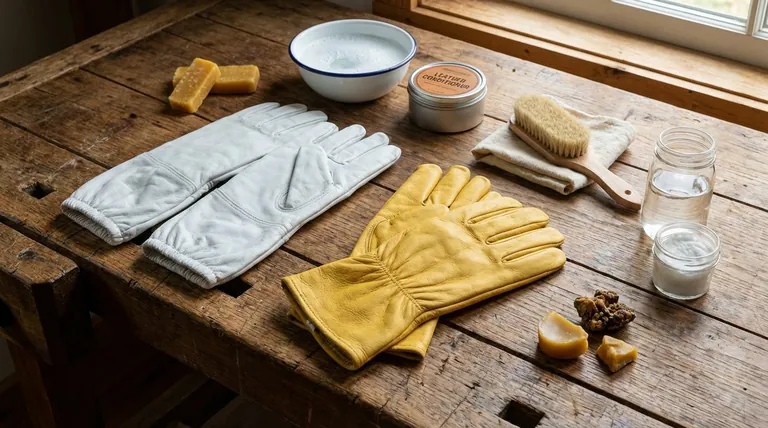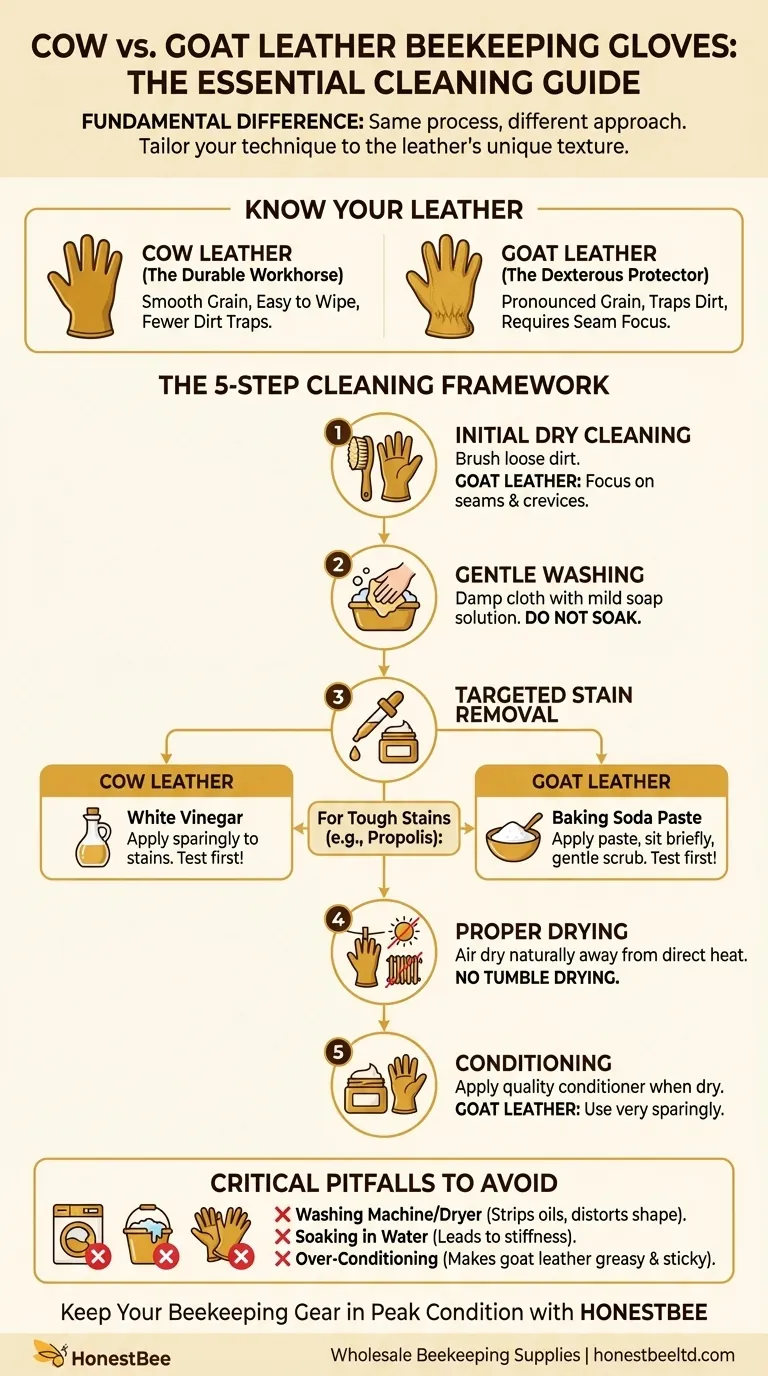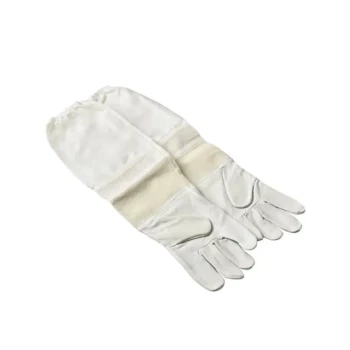The fundamental cleaning process for cow and goat leather beekeeping gloves is the same, but the key differences lie in the stain removal techniques and the attention to detail required. Cow leather is smoother and more durable, while goat leather is softer with a more pronounced grain that can trap more dirt, requiring more focus on cleaning seams and crevices.
The core difference in cleaning cow versus goat leather is not the overall method, but the specific adjustments you must make for each material's unique texture and properties—particularly when tackling stubborn stains and applying conditioner.

Why Cleaning Methods Differ: It Starts with the Leather
To clean your gloves effectively, you must first understand the material you are working with. The inherent properties of cowhide and goatskin dictate the subtle but important variations in their care.
Cow Leather: The Durable Workhorse
Cow leather is known for its durability and smoother grain. This makes it an excellent material for heavy-duty beekeeping tasks.
Its smooth surface is generally easier to wipe clean, as dirt and propolis have fewer places to become deeply embedded.
Goat Leather: The Dexterous Protector
Goat leather is prized for its softness and pliability, offering beekeepers superior dexterity and feel.
However, its more pronounced, textured grain can hold onto dirt, wax, and propolis more tenaciously, especially in the seams and natural crevices of the material.
The Step-by-Step Cleaning Framework
While the materials differ, the cleaning process follows the same five essential steps. Your technique at each stage is what matters.
Step 1: Initial Dry Cleaning
First, use a soft-bristled brush to remove all loose surface dirt, dust, and wax.
For goat leather, pay special attention to brushing out the seams and crevices, where debris is more likely to accumulate.
Step 2: Gentle Washing
Prepare a solution of mild soap (like saddle soap or a gentle detergent) and warm water. Do not use harsh chemicals.
Dip a soft cloth or brush into the soapy water and gently scrub the surface of the gloves. The goal is to clean the surface, not to soak the leather through.
Step 3: Targeted Stain Removal
This is the most critical point of differentiation. For tough, built-up stains like propolis:
For cow leather, you can apply a small amount of white vinegar to the stain. Always test this on a small, inconspicuous area first to ensure it doesn't cause discoloration.
For goat leather, a mixture of baking soda and water formed into a paste is more suitable. Apply it to the stain, let it sit briefly, and gently scrub. Again, always test on a hidden spot first.
Step 4: Proper Drying
After cleaning, wipe off any excess moisture with a clean, dry towel.
Allow the gloves to air dry naturally away from direct sunlight or any heat source, like a radiator. Hanging them is ideal. Forced heat will cause the leather to shrink, stiffen, and crack.
Step 5: Conditioning the Leather
Once the gloves are completely dry, apply a quality leather conditioner. This restores essential oils, keeping the leather supple and preventing it from cracking.
Use a clean cloth to work a small amount of conditioner into the leather. For goat leather, be particularly sparing, as its softness allows it to absorb oils very easily.
Understanding the Trade-offs and Pitfalls
Proper cleaning maintains your gloves, but improper methods can ruin them. Avoiding common mistakes is as important as following the right steps.
Never Use a Washing Machine or Dryer
The aggressive tumbling, high heat, and excessive water of a washing machine and dryer will strip the leather of its natural oils, severely distort its shape, and cause it to become brittle.
Avoid Soaking the Leather
Submerging or soaking leather gloves in water is counterproductive. It saturates the material, and as the water evaporates, it draws out the natural oils that keep the leather pliable, leading to stiffness.
The Risk of Over-Conditioning
While conditioning is vital, using too much can make the gloves feel greasy and heavy. This is especially true for the more porous goat leather, which can become sticky and attract more dirt if over-conditioned.
Making the Right Choice for Your Gloves
Your approach should be tailored to your specific gloves to ensure they remain protective and comfortable for seasons to come.
- If you are cleaning durable cow leather gloves: Focus on a robust cleaning with a mild soap solution, using white vinegar sparingly for any stubborn propolis stains.
- If you are cleaning softer goat leather gloves: Be meticulous when brushing out seams, use a gentler scrubbing motion, and employ a baking soda paste for stains, being careful not to over-condition.
- For any leather gloves: Always test new cleaning agents on a hidden spot first and prioritize air-drying and proper conditioning to maintain flexibility and protection.
By adapting your technique to the specific needs of the leather, you preserve the function, comfort, and lifespan of your most essential protective gear.
Summary Table:
| Cleaning Step | Cow Leather Focus | Goat Leather Focus |
|---|---|---|
| Stain Removal | Use white vinegar sparingly on tough stains. | Use a baking soda paste for gentle, effective cleaning. |
| Brushing | Smooth surface is easier to wipe clean. | Pay extra attention to seams and textured grain. |
| Conditioning | Apply conditioner to restore oils. | Use sparingly to avoid a greasy feel. |
| Key Trait | Durable and smooth. | Soft, pliable, and textured. |
Keep Your Beekeeping Gear in Peak Condition with HONESTBEE
Proper glove maintenance is just one part of a successful beekeeping operation. At HONESTBEE, we supply commercial apiaries and beekeeping equipment distributors with the durable, high-quality supplies needed for efficiency and protection. From gloves to full suits and hive tools, our wholesale-focused operations ensure you get the reliable gear your business depends on.
Let us help you equip your team for success. Contact HONESTBEE today to discuss your wholesale supply needs and discover how our products can enhance your productivity and safety.
Visual Guide

Related Products
- Beekeeping Gloves Goatskin Leather with Long Cotton Sleeve for Beekeepers
- Goatskin Leather Beekeeper Gloves with Vent Long Sleeve for Beekeeping Honey Bee Sting Proof Protection
- Goat Skin Leather Bee Sting Proof Beekeeping Gloves with Canvas Sleeve
- Mesh Ventilated 3 Layer Goatskin Beekeepers Gloves for Beekeeping
- Professional Galvanized Hive Strap with Secure Locking Buckle for Beekeeping
People Also Ask
- What are the arguments for and against using gloves in beekeeping? Balancing Protection and Dexterity
- What are the features of ventilated bee gloves? Stay Cool & Dexterous in Warm Weather
- Why are protective gloves important in beekeeping? Boost Confidence & Safety in Your Apiary
- Should beekeepers wear gloves, and why? Essential Protection for Beekeepers
- What are the advantages of goatskin leather gloves for beekeeping? Superior Sting Protection for Your Apiary



















